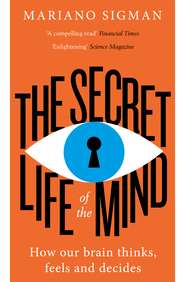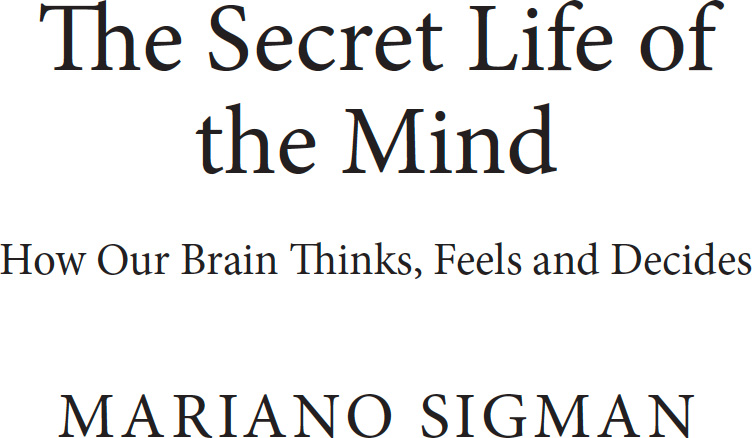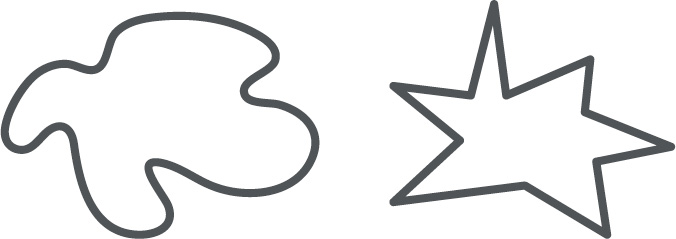
Полная версия:
The Secret Life of the Mind: How Our Brain Thinks, Feels and Decides



Copyright
William Collins
An imprint of HarperCollinsPublishers
1 London Bridge Street
London SE1 9GF
www.WilliamCollinsBooks.com
This eBook first published in Great Britain by William Collins in 2017
Copyright © 2015 Mariano Sigman
Copyright © 2015, Penguin Random House Grupo Editorial, S. A. Buenos Aires
Copyright © 2015, Penguin Random House Grupo Editorial,
S. A. U. Travessera de Gracia, 47–49. 08021 Barcelona
English translation © Mariano Sigman 2017
Text on p.84 from The Simpsons, Season 2 Episode 12, ‘The Way We Was’, written by Al Jean & Mike Reiss and Sam Simon, originally aired January 31, 1991.
© Fox Broadcasting Company. All rights reserved.
Mariano Sigman asserts the moral right to be identified as the author of this work
A catalogue record for this book is available from the British Library
All rights reserved under International and Pan-American Copyright Conventions. By payment of the required fees, you have been granted the non-exclusive, non-transferable right to access and read the text of this e-book on-screen. No part of this text may be reproduced, transmitted, down-loaded, decompiled, reverse engineered, or stored in or introduced into any information storage and retrieval system, in any form or by any means, whether electronic or mechanical, now known or hereinafter invented, without the express written permission of HarperCollins
Source ISBN: 9780008210922
Ebook Edition © June 2017 ISBN: 9780008210939
Version: 2018-05-30
From the international reviews of The Secret Life of the Mind:
‘To read minds nowadays, one doesn’t need to be a magician or clairvoyant. As science takes leaps and bounds towards understanding the mysteries of consciousness, Mariano Sigman, one of the most notable neuroscientists of today, has written a book on just this subject’
Revista Nueva
‘The brain is the star of this book, with chapters focusing on its characteristics throughout childhood and youth, identity, decision-making, consciousness, education and its capacity to transform itself. In exploring the psychological element of neuroscience, Mariano Sigman tells the story of the human mind as a journey through some of the least travelled paths of mankind … A wonderful read’
La Nacion
‘Sigman confirms that although we are capable of detecting and manipulating consciousness, science is still not able to physically break it down. The idea of the mind as a tabula rasa is only one of many erroneous notions that Sigman’s brilliant book helps to correct’
El Cultural, El Mundo
‘What makes The Secret Life of the Mind a great read is Sigman’s solid capacity as a scientific storyteller’
Clarin
‘In his latest publication, Sigman takes readers on a new journey into their own minds. This introspective journey attempts to access the deepest parts of our brain, where maybe even the secret of human essence lies’
RTVE
‘What differentiates The Secret Life of the Mind from other books about the mind is that it takes on neuroscience from a psychological point of view, as well as taking into account psychoanalysis, behavioural economics and philosophy’
Nosotras
‘Sigman takes us on an entertaining journey through the brain to show us how we make decisions, how we feel and how we think’
El Confidencial
‘The Secret Life of the Mind proposes a journey similar to that undertaken by Carl Sagan in Cosmos aboard his vessel of knowledge, but in this case through our inner universe’
Federico Kukso, Le Monde diplomatique
Dedication
To Milo and Noah
Contents
Cover
Title Page
Copyright
Praise
Dedication
Introduction
1: The origin of thought
How do babies think and communicate, and how can we understand them better?
The genesis of concepts
Atrophied and persistent synaesthesias
The mirror between perception and action
Piaget’s mistake!
The executive system
The secret in their eyes
Development of attention
The language instinct
Mother tongue
The children of Babel
A conjecturing machine
The good, the bad and the ugly
He who robs a thief …
The colour of a jersey, strawberry or chocolate
Émile and Minerva’s owl
I, me, mine and other permutations by George
Transactions in the playground, or the origin of commerce and theft
Jacques, innatism, genes, biology, culture and an image
2: The fuzzy borders of identity
What defines our choices and allows us to trust other people and our own decisions?
Churchill, Turing and his labyrinth
Turing’s brain
Turing in the supermarket
The tell-tale heart
The body in the casino and at the chessboard
Rational deliberation or hunches?
Sniffing out love
Believing, knowing, trusting
Confidence: flaws and signatures
The nature of optimists
Odysseus and the consortium we belong to
Flaws in confidence
Others’ gazes
The inner battles that make us who we are
The chemistry and culture of confidence
The seeds of corruption
The persistence of social trust
To sum up …
3: The machine that constructs reality
How does consciousness emerge in the brain and how are we governed by our unconscious?
Lavoisier, the heat of consciousness
Pyschology in the prehistory of neuroscience
Freud working in the dark
Free will gets up off the couch
The interpreter of consciousness
‘Performiments’: freedom of expression
The prelude to consciousness
In short: the circle of consciousness
The physiology of awareness
Reading consciousness
Observing the imagination
Shades of consciousness
Do babies have consciousness?
4: Voyages of consciousness (or consciousness tripping)
What happens in the brain as we dream; is it possible for us to decipher, control and manipulate our dreams?
Altered states of consciousness
Nocturnal elephants
The uroboros plot
Deciphering dreams
Daydreams
Lucid dreaming
Voyages of consciousness
The factory of beatitude
The cannabic frontier
Towards a positive pharmacology
The consciousness of Mr X
The lysergic repertoire
Hoffman’s dream
The past and the future of consciousness
The future of consciousness: is there a limit to mind-reading?
5: The brain is constantly transforming
What makes our brain more or less predisposed to change?
Virtue, oblivion, learning, and memory
The universals of human thought
The illusion of discovery
Learning through scaffolding
Effort and talent
Ways of learning
The OK threshold
The history of human virtue
Fighting spirit and talent: Galton’s two errors
The fluorescent carrot
The geniuses of the future
Memory palace
The morphology of form
A monster with slow processors
Our inner cartographers
Fluorescent triangles
The parallel brain and the serial brain
Learning: a bridge between two pathways in the brain
The repertoire of functions: learning is compiling
Automatizing reading
The ecology of alphabets
The morphology of the word
The two brains of reading
The temperature of the brain
6: Educated brains
How can we use what we have learned about the brain and human thought to improve education?
The sound of the letters
Word-tied
What we have to unlearn
The framework of thought
Parallelawhat?
Gestures and words
Good, bad, yes, no, OK
The teaching instinct
Spikes of culture
Docendo discimus
Epilogue
Appendix
Footnotes
Bibliography
Acknowledgements
About the Author
About the Publisher
INTRODUCTION
I like to think of science as a ship that takes us to unknown places, the remotest parts of the universe, into the inner workings of light and the tiniest molecules of life. This ship has instruments, telescopes and microscopes, which make visible what was once invisible. But science is also the route itself, the binnacle, the chart leading us towards the unknown.
My voyage over the last twenty years, between New York, Paris and Buenos Aires, has been into the innermost parts of the human brain, an organ composed of countless neurons that codify perception, reason, emotions, dreams and language.
The goal of this book is to discover our mind in order to understand ourselves more deeply, even in the tiniest recesses that make up who we are. We will look at how we form ideas during our first days of life, how we give shape to our fundamental decisions, how we dream and how we imagine, why we feel certain emotions, how the brain transforms and how who we are changes along with it.
Throughout these pages we will see the brain from a distance. We will go where thought begins to take shape. And it is there where psychology meets neuroscience. This is the ocean in which many people of varied disciplines have sailed, including biologists, physicists, mathematicians, psychologists, anthropologists, linguists, philosophers, doctors. As well as chefs, magicians, musicians, chess masters, writers, artists. This book is a result of that amalgam.
The first chapter is a journey to the land of childhood. We will see that the brain is already prepared for language long before we begin to speak, that bilingualism helps us to think, and that early on we form notions of what is good and what is fair, and about cooperation and competition, that later affect how we relate to ourselves and others. This early intuitive thinking leaves lasting traces on the way we reason and decide.
In the second chapter we will explore what defines the blurry, fine line between what we are willing to do and what we aren’t. Those decisions that make us who we are. How do reason and feelings work together in social and emotional decisions? What makes us trust others and ourselves? We will discover that small differences in decision-making brain circuits can drastically change our way of deciding, from the simplest decisions to the most profound and sophisticated ones that define us as social beings.
The third and fourth chapters travel into the most mysterious aspect of thought and the human brain – consciousness – through an unprecedented meeting between Freud and the latest neuroscience. What is the unconscious and how does it control us? We will see that we can read and decipher thoughts by decoding patterns of brain activity, even in vegetative patients who have no other way to express themselves. And who is it that awakens when consciousness awakens? We will see the first sketches of how we can now record our dreams and visualize them within some sort of oneiric planetarium, and explore the fauna of different states of consciousness, like lucid dreams and thinking under the effects of marijuana or hallucinogenic drugs.
The last two chapters cover questions of how the brain learns in different circumstances, from everyday life to formal education. For example, is it true that learning a new language is much harder for an adult than for a child? We will take a journey into the history of learning, looking at effort and ability, the drastic transformation that takes place in the brain when we learn to read, and the brain’s predisposition to change. This book outlines how all this knowledge can be used responsibly to improve the largest collective experiment in the history of humanity: school.
The Secret Life of the Mind is a summary of neuroscience from the perspective of my own experience. I look at neuroscience as a way to help us communicate with each other. From this perspective, neuroscience is another tool in humanity’s ancestral search to express – sometimes rudimentarily – the shades, colours and nuances of what we feel and what we think in order to be comprehensible to others and, of course, to ourselves.
CHAPTER ONE
The origin of thought
How do babies think and communicate, and how can we understand them better?
Of all the places we travel throughout our lifetimes, the most extraordinary is certainly the land of childhood: a territory that, looked back on by the adult, becomes a simple, naive, colourful, dreamlike, playful and vulnerable space.
It’s odd. We were all once citizens of that country, yet it is hard to remember and reconstruct it without dusting off photos in which, from a distance, we see ourselves in the third person, as if that child were someone else and not us in a different time.
How did we think and conceive of the world before learning the words to describe it? And, while we are at it, how did we discover those words without a dictionary to define them? How is it possible that before three years of age, in a period of utter immaturity in terms of formal reasoning, we were able to discover the ins and outs of grammar and syntax?
Here we will sketch out that journey, from the day we entered the world to the point where our language and thought resemble what we employ today as adults. The trajectory makes use of diverse vehicles, methods and tools. It intermingles reconstructions of thought from our gazes, gestures and words, along with the minute inspection of the brain that makes us who we are.
We will see that, from the day we are born, we are already able to form abstract, sophisticated representations. Although it sounds far-fetched, babies have notions of mathematics, language, morality, and even scientific and social reasoning. This creates a repertoire of innate intuitions that structure what they will learn – what we all learned – in social, educational and family spaces, over the years of childhood.
We will also discover that cognitive development is not the mere acquisition of new abilities and knowledge. Quite the contrary, it often consists in undoing habits that impede children from demonstrating what they already know. On occasion, and despite it being a counterintuitive idea, the challenge facing children is not acquiring new concepts but rather learning to manage those they already possess.
I have observed that we, as adults, often draw babies poorly because we don’t realize that their body proportions are completely different from ours. Their arms, for example, are barely the size of their heads. Our difficulty in seeing them as they are serves as a morphological metaphor for understanding what is most difficult to sense in the cognitive sphere: babies are not miniature adults.
In general, for simplicity and convenience, we speak of children in the third person, which erroneously assumes a distance, as if we were talking about something that is not us. Since this book’s intention is to travel to the innermost recesses of our brain, this first excursion, to the child we once were, will be in the first person in order to delve into how we thought, felt and represented the world in those days we can no longer recall, simply because that part of our experience has been relegated to oblivion.
The genesis of concepts
In the late seventeenth century, an Irish philosopher, William Molyneux, suggested the following mental experiment to his friend John Locke:
Suppose a man born blind, and now adult, and taught by his touch to distinguish between a cube and a sphere [ … ] Suppose then the cube and the sphere placed on a table, and the blind man made to see: query, Whether by his sight, before he touched them, he could now distinguish and tell which is the globe, which the cube?
Could he? In the years that I have been asking this question I’ve found that the vast majority of people believe that the answer is no. That the virgin visual experience needs to be linked to what is already known through touch. Which is to say, that a person would need to feel and see a sphere at the same time in order to discover that the gentle, smooth curve perceived by the fingertips corresponds to the image of the sphere.
Others, the minority, believe that the previous tactile experience creates a visual mould. And that, as a result, the blind man would be able to distinguish the sphere from the cube as soon as he could see.
John Locke, like most people, thought that a blind man would have to learn how to see. Only by seeing and touching an object at the same time would he discover that those sensations are related, requiring a translation exercise in which each sensory mode is a different language, and abstract thought is some sort of dictionary that links the tactile words with the visualized words.
For Locke and his empiricist followers, the brain of a newborn is a blank page, a tabula rasa ready to be written on. As such, experience goes about sculpting and transforming it, and concepts are born only when they acquire a name. Cognitive development begins on the surface with sensory experience, and, then, with the development of language, it acquires the nuances that explain the deeper and more sophisticated aspects of human thought: love, religion, morality, friendship and democracy.
Empiricism is based on a natural intuition. It is not surprising, then, that it has been so successful and that it dominated the philosophy of the mind from the seventeenth century to the time of the great Swiss psychologist Jean Piaget. However, reality is not always intuitive: the brain of a newborn is not a tabula rasa. Quite the contrary. We already come into the world as conceptualizing machines.
The typical café discussion reasoning comes up hard against reality in a simple experiment carried out by a psychologist, Andrew Meltzoff, in which he tested a version of Molyneux’s question in order to refute empirical intuition. Instead of using a sphere and a cube, he used two dummies: one smooth and rounded and the other more bumpy, with nubs. The method is simple. In complete darkness, babies had one of the two pacifiers in their mouths. Later, the pacifiers are placed on a table and the light is turned on. And the babies looked more at the pacifier they’d had in their mouths, showing that they recognize it.
The experiment is very simple and destroys a myth that had persisted over more than three hundred years. It shows that a newborn with only tactile experience – contact with the mouth, since at that age tactile exploration is primarily oral as opposed to manual – of an object has already conceived a representation of how it looks. This contrasts with what parents typically perceive: that newborn babies’ gazes often seem to be lost in the distance and disconnected from reality. As we will see later, the mental life of children is actually much richer and more sophisticated than we can intuit based on their inability to communicate it.
Atrophied and persistent synaesthesias
Meltzoff’s experiment gives – against all intuition – an affirmative response to Molyneux’s question: newborn babies can recognize by sight two objects that they have only touched. Does the same thing happen with a blind adult who begins to see? The answer to this question only recently became possible once surgeries were able to reverse the thick cataracts that cause congenital blindness.
The first actual materialization of Molyneux’s mental experiment was done by the Italian ophthalmologist Alberto Valvo. John Locke’s prophecy was correct; for a congenitally blind person, gaining sight was nothing like the dream they had longed for. This was what one of the patients said after the surgery that allowed him to see:
I had the feeling that I had started a new life, but there were moments when I felt depressed and disheartened, when I realized how difficult it was to understand the visual world. [ … ] In fact, I see groups of lights and shadows around me [ … ] like a mosaic of shifting sensations whose meaning I don’t understand. [ … ] At night, I like the darkness. I had to die as a blind person in order to be reborn as a seeing person.
This patient felt so challenged by suddenly gaining sight because while his eyes had been ‘opened’ by the surgery, he still had to learn to see. It was a big and tiresome effort to put together the new visual experience with the conceptual world he had built through his senses of hearing and touch. Meltzoff proved that the human brain has the ability to establish spontaneous correspondences between sensory modalities. And Valvo showed that this ability atrophies when in disuse over the course of a blind life.
On the contrary, when we experience different sensory modalities, some correspondences between them consolidate spontaneously over time. To prove this, my friend and colleague Edward Hubbard, along with Vaidyanathan Ramachandran, created the two shapes that we see here. One is Kiki and the other is Bouba. The question is: which is which?

Almost everyone answers that the one on the left is Bouba and the one on the right is Kiki. It seems obvious, as if it couldn’t be any other way. Yet there is something strange in that correspondence; it’s like saying someone looks like a Carlos. The explanation for this is that when we pronounce the vowels /o/y/u/, our lips form a wide circle, which corresponds to the roundness of Bouba. And when saying the /k/, or /i/, the back part of the tongue rises and touches the palate in a very angular configuration. So the pointy shape naturally corresponds with the name Kiki.



